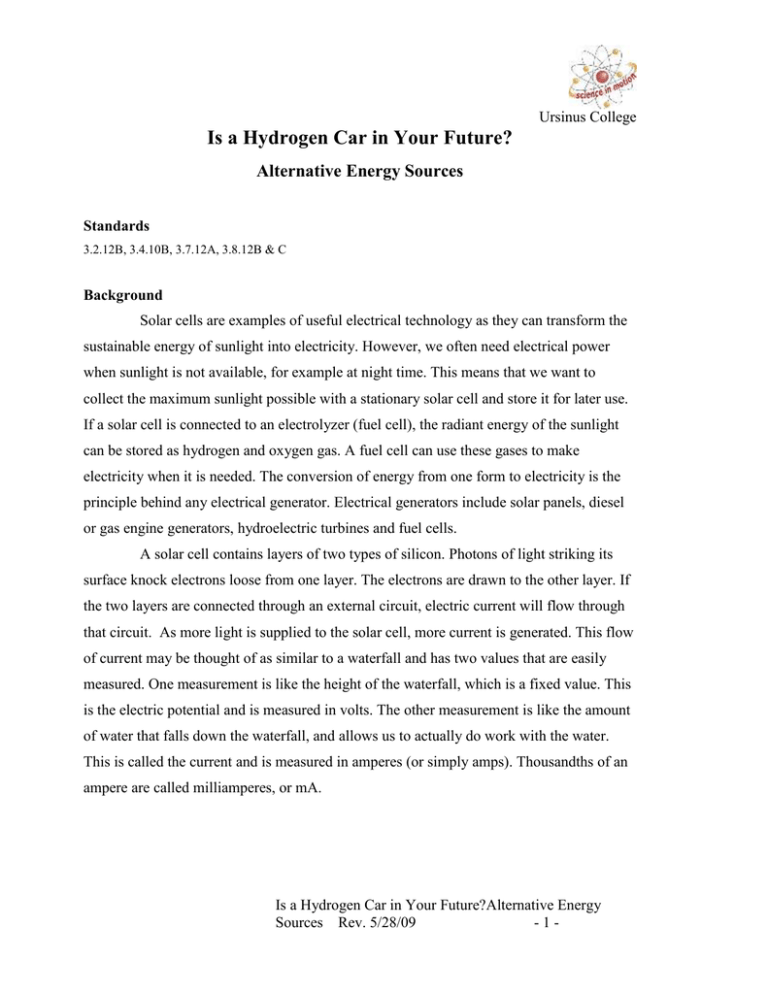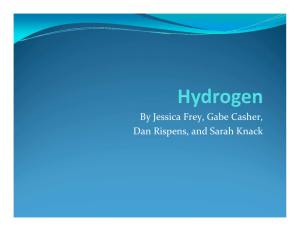Is a Hydrogen Car in Your Future? Alternative Energy Sources
advertisement

Ursinus College Is a Hydrogen Car in Your Future? Alternative Energy Sources Standards 3.2.12B, 3.4.10B, 3.7.12A, 3.8.12B & C Background Solar cells are examples of useful electrical technology as they can transform the sustainable energy of sunlight into electricity. However, we often need electrical power when sunlight is not available, for example at night time. This means that we want to collect the maximum sunlight possible with a stationary solar cell and store it for later use. If a solar cell is connected to an electrolyzer (fuel cell), the radiant energy of the sunlight can be stored as hydrogen and oxygen gas. A fuel cell can use these gases to make electricity when it is needed. The conversion of energy from one form to electricity is the principle behind any electrical generator. Electrical generators include solar panels, diesel or gas engine generators, hydroelectric turbines and fuel cells. A solar cell contains layers of two types of silicon. Photons of light striking its surface knock electrons loose from one layer. The electrons are drawn to the other layer. If the two layers are connected through an external circuit, electric current will flow through that circuit. As more light is supplied to the solar cell, more current is generated. This flow of current may be thought of as similar to a waterfall and has two values that are easily measured. One measurement is like the height of the waterfall, which is a fixed value. This is the electric potential and is measured in volts. The other measurement is like the amount of water that falls down the waterfall, and allows us to actually do work with the water. This is called the current and is measured in amperes (or simply amps). Thousandths of an ampere are called milliamperes, or mA. Is a Hydrogen Car in Your Future?Alternative Energy Sources Rev. 5/28/09 -1- Ursinus College Electrolysis is the use of an electric current to take a compound apart. Water, formula H2O, is a compound containing two atoms of hydrogen and one atom of oxygen. This investigation will introduce a way to break up water with electricity by having it flow through an electrolyzer (fuel cell.) The electricity to break up the water will come from the solar panel. The solar panel converts light into current. This current splits water into hydrogen and oxygen in the fuel cell. The hydrogen and oxygen are then converted back into current in the fuel cell. The current drives the electric motor of the car. Since the early 1960s car companies have been working on fuel cell cars, producing prototypes with impressive features such as a traveling distance of 200 km with one hydrogen filling. Although little has been done towards commercializing a hydrogen powered vehicle the recent threat of California’s zero-emission policy has caused car companies to respond. Today the car companies are on the verge of producing fuel cell cars in quantity. These cars meet all the needs today’s customers demand. Several police and fire departments in the USA possess fuel cell powered vehicles. Some European towns have changed part of their public transportation bus fleet to fuel cell powered busses. British Columbia, Canada plans to have the first hydrogen bus fleet ready for public transportation during the Winter Olympics 2010. Guiding Questions What are some potential positives and negatives to using solar energy? Other than gasoline, what energy sources could be used to power a motor vehicle? What are some challenges involved with mass producing non-gasoline powered vehicles? Knowing the volume of consumed hydrogen gas and the total distance covered in meters, explain how to calculate the gas mileage in miles per gallon for the Fuel Cell Kit Car? Is a Hydrogen Car in Your Future?Alternative Energy Sources Rev. 5/28/09 -2- Ursinus College Equipment Car with motor Load measurement box Distilled water 500 Watt utility light Ruler Safety Wear safety goggles No open flames Distilled water only Keep minimum distance of 20 cm (8 inches) between light source and solar panel Do not concentrate light Do not touch the hot surface of the solar panel or lamp Procedure 1. Place the fuel cell upside down (numbers facing down) on the flat surface. 2. Remove the stoppers. 3. Pour DISTILLED water into both storage cylinders until the water reaches the tops of the small tubes in the center of the cylinders. Is a Hydrogen Car in Your Future?Alternative Energy Sources Rev. 5/28/09 -3- Ursinus College 4. Tap the fuel cell lightly to help water flow into the area surrounding the membrane and metal current-collecting plates. 5. Add more water until it starts to overflow into the tubes in the cylinders. 6. Place the stoppers back onto the cylinders. Make sure no air is trapped inside the cylinder. 7. Turn the reversible fuel cell right side up. Is a Hydrogen Car in Your Future?Alternative Energy Sources Rev. 5/28/09 -4- Ursinus College 8. Plug one end of the red patch cord into the red jack of the solar panel (1) and the other end into the red jack of the fuel cell (3). 9. Repeat step 8 with the black patch cord and the black jacks (2, 4). 10. Align the solar panel with the light source keeping a minimum distance of 20 cm (8 inches). 11. Turn on the light. 12. When the hydrogen storage cylinder is filled to a little more than 12ml, turn off the light and record the exact volume in ml of hydrogen gas. 13. Unplug the patch cords from the reversible fuel cell. 14. With the red and black terminals facing towards the front of the car, place the reversible fuel cell into the notches on the model car until it audibly clicks into place. 15. Connect the red (positive) banana jack with the red (positive) terminal. 16. When the car is in racing position connect the black (negative) banana jack with the black (negative) terminal. 17. When the car stops moving, measure the total distance traveled in meters. Is a Hydrogen Car in Your Future?Alternative Energy Sources Rev. 5/28/09 -5- Ursinus College Data Consumed volume of hydrogen gas _______ mL Total distance traveled _______ m Calculations 1. Using your data, calculate the gas mileage for the Fuel Cell Kit car in miles per gallon. Show all work. 2. Assuming the lab was performed at standard temperature and pressure (STP), show the necessary work to convert the gas volume in ml of hydrogen to liquid volume in ml of hydrogen. 3. Recalculate the gas mileage of the fuel cell kit car in miles per gallon using the liquid volume of hydrogen from the previous question. Questions 1. Write the chemical reaction for electrolysis. 2. Write the reaction that is occurring within the fuel cell while it is powering the car motor? 3. Why are the products of the hydrogen fuel cell reaction preferable to the products of gasoline combustion? References Revised from Heliocentris Dr FuelCellTM Model Car Laboratory Manual, Heliocentris Energiesysteme GmbH, Rudower Chaussee 29, 12489 Berlin, Germany Is a Hydrogen Car in Your Future?Alternative Energy Sources Rev. 5/28/09 -6- Ursinus College Teacher Notes. The Solar Panels are most fragile. They must not be bent! Make sure students do not place the artificial light source any closer than the 20 cm noted in the procedure. Distilled water ONLY must be used in the fuel cells. Students must wash and rinse hands thoroughly before handling the fuel cell. Unwashed and un-rinsed hands contain harmful ions. Approximate time: About 15 minutes to set up. About 15 minutes to charge the fuel cell. About 10 minutes to “race” the cars. Can be done in one standard non-block class period. Answers to Questions: Guiding Questions 1. What are some potential positives and negatives to using solar energy? Answers will vary. 2. Other than gasoline, what energy sources could be used to power a motor vehicle? Electricity, solar, biofuels etc. 3. What are some challenges involved with mass producing non-gasoline powered vehicles? Politics surrounding oil production/consumption and the profits involved, patents, rebuilding car production plants, time and resources for research and design 4. Knowing the volume of consumed hydrogen gas and the total distance covered in meters, explain how to calculate the gas mileage in miles per gallon for the Fuel Cell Kit Car? Convert ml to gallons using standard conversion factors. Convert meters to miles using standard conversion factors. Divide miles by gallons. Calculations 1. Using your data, calculate the gas mileage for the Fuel Cell Kit car in miles per gallon. Show all work. Convert meters to miles (1 mile = 1609 m). Convert ml to gallons (1 gallon = 3785 ml). Divide miles by gallons. Is a Hydrogen Car in Your Future?Alternative Energy Sources Rev. 5/28/09 -7- Ursinus College 2. Assuming the lab was performed at standard temperature and pressure (STP), show the necessary work to convert the gas volume in ml of hydrogen to liquid volume in ml of hydrogen. Convert gas ml to liters ( 1 liter = 1000 ml). Convert liters of gas to moles (1 mole = 22.4 L). Convert moles of hydrogen to grams ( 1 mole = 1.00794 g H). Use the density of liquid hydrogen to convert grams to liquid ml (density of liquid hydrogen = .07 g/ml) 3. Recalculate the gas mileage of the fuel cell kit car in miles per gallon using the liquid volume of hydrogen from the previous question. Divide miles per liquid volume in ml. Questions 1. Write the chemical reaction for electrolysis. Electricity + 2H2O 2H2 + O2 2. Write the reaction that is occurring within the fuel cell while it is powering the car motor? 2H2 + O2 Electricity + 2H2O 3. Why are the products of the hydrogen fuel cell reaction preferable to the products of gasoline combustion? Water is not harmful to the environment and gasoline engine emissions such as nitrogen gas, carbon dioxide, carbon monoxide, hydrocarbons and nitrogen oxides are contributing to global warming. Is a Hydrogen Car in Your Future?Alternative Energy Sources Rev. 5/28/09 -8-


